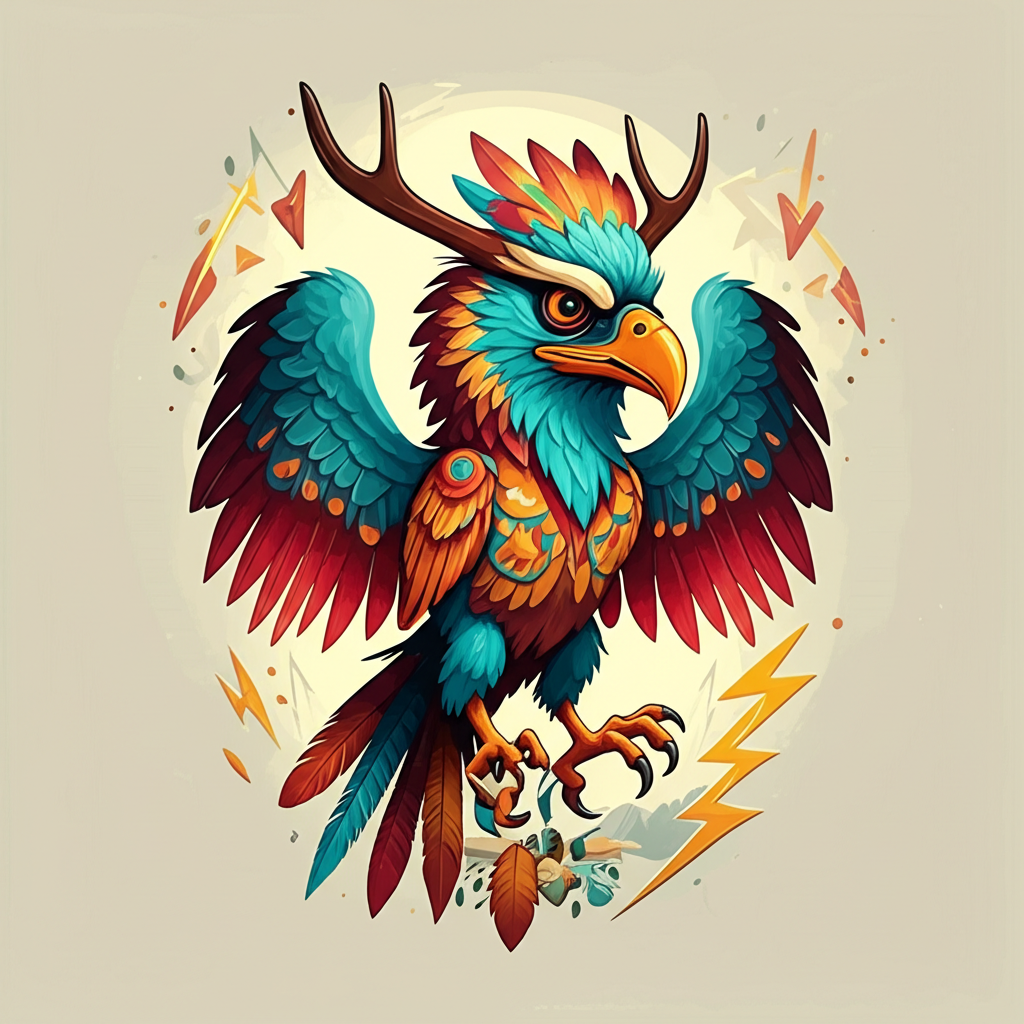
The vast, wind-swept expanse of the North American Great Plains, a land of boundless skies and resilient life, has long been a cradle for rich and intricate mythologies. Among the ancestral stories whispered around countless campfires, tales of powerful beings and cautionary figures played a vital role in shaping understanding and transmitting wisdom. One such narrative, woven from the threads of ancient belief systems, speaks of the awe-inspiring Thunderbird and the chilling entity known as the Wendigo. It is crucial to understand that these are traditional stories, born from the imagination and worldview of ancient peoples, offering a glimpse into their understanding of the world, not a literal account of reality.
To grasp the context of these legends, we must journey back in time, to a period when the Great Plains were a different world. Societies of Indigenous peoples, deeply connected to the rhythms of nature, viewed the universe as a living, interconnected entity. Every element, from the smallest blade of grass to the mightiest storm, possessed a spirit and a purpose. The natural world was not merely a backdrop for human existence, but an active participant, capable of bestowing blessings or unleashing formidable challenges. In such a worldview, it was natural for human experiences, particularly those of profound wonder or deep fear, to be personified and attributed to powerful, often supernatural, forces. The harsh realities of life on the plains – the unpredictable weather, the constant struggle for sustenance, the ever-present threat of starvation – undoubtedly fueled the creation of stories that explored these extremes.
At the heart of many Plains Indigenous mythologies lies the majestic Thunderbird. This colossal, mythical bird, often depicted with feathers like storm clouds and eyes that flashed like lightning, was a potent symbol of power and a harbinger of change. Its flight was said to create thunder, and its tears, the rain that nourished the land. The Thunderbird was not a malevolent force, but a creature of immense authority, capable of both destruction and creation. It embodied the raw, untamed power of the skies, a force that demanded respect and awe. Its presence in stories often signified great events, blessings, or the need for courage and resilience in the face of overwhelming natural phenomena.
In stark contrast to the grandeur of the Thunderbird, the Wendigo emerged from the shadows of ancient anxieties. This figure, often described as a gaunt, emaciated creature with hollow eyes and an insatiable hunger, represented the terrifying specter of starvation and the grim consequences of greed and cannibalism. The Wendigo was not a natural entity in the same way as the Thunderbird; rather, it was a manifestation of the darkest aspects of the human condition, amplified by the unforgiving environment of the northern forests and, by extension, the harsh realities that could plague even the open plains. Its very existence was a chilling reminder of what could happen when the balance of nature, and the bonds of community, were broken.
Imagine, then, a narrative unfolding across the vast, rolling landscapes of the Great Plains. The sun beats down relentlessly, baking the earth. A prolonged drought has gripped the land, and whispers of hunger begin to circulate through the villages. The elders, their faces etched with concern, recall the stories of the Thunderbird, a being that could summon the life-giving rains. They speak of its power, its majesty, and the respect it commanded. They might tell of how, in times of great need, brave individuals would offer prayers and perform rituals, hoping to draw the attention of this celestial guardian.
But as the days turn into weeks, and the parched earth cracks further, a different kind of fear begins to take root. The stories then turn to the Wendigo, a cautionary tale whispered with hushed tones. It is said that when people succumb to despair, to selfishness, and to the unthinkable act of preying on their own kind out of desperation, the spirit of the Wendigo can take hold. This chilling entity, driven by an eternal, gnawing hunger, is the embodiment of the ultimate taboo, the horrifying consequence of losing one’s humanity in the face of extreme adversity. The Wendigo represents the primal fear of not just physical death, but of spiritual annihilation, of becoming something monstrous and alone, forever consumed by an unquenchable craving.
The stories might weave these two figures together in a delicate balance. Perhaps the Thunderbird, in its immense power, could also unleash devastating storms that tested the people’s resilience, mirroring the internal storms of fear and desperation that could lead to the emergence of the Wendigo. Or perhaps, in the aftermath of such natural fury, when resources were scarce, the threat of the Wendigo loomed larger, a stark reminder of the moral choices individuals faced. These narratives served as a complex tapestry of the human experience, acknowledging both the awe-inspiring forces of nature and the internal struggles that defined survival.
The symbolism embedded within these ancient tales is profound and multi-layered. The Thunderbird, with its connection to the sky and storms, represented the immense, often unpredictable, power of the natural world. It could be a source of life-giving rain or destructive tempests, a reminder of humanity’s smallness in the face of cosmic forces. It also symbolized hope and the potential for renewal. The Wendigo, on the other hand, served as a powerful moral compass. It was a stark personification of the dangers of greed, selfishness, and the breakdown of community during times of hardship. It embodied the fear of starvation, not just physically, but spiritually – the fear of losing one’s humanity and becoming consumed by primal, destructive desires. These stories, therefore, acted as vital mechanisms for social cohesion and ethical instruction, reinforcing the importance of cooperation, empathy, and respect for both the natural world and one’s fellow beings.
In the modern era, the echoes of these ancient myths continue to resonate, albeit in different forms. The Thunderbird and the Wendigo have transcended their original cultural contexts, finding new life in literature, film, and popular culture. Contemporary interpretations often explore themes of primal fear, the wilderness, and the darker aspects of human nature. The Wendigo, in particular, has become a recurring antagonist in horror genres, symbolizing an insatiable, monstrous hunger that reflects anxieties about consumption and the wilderness encroaching on civilization. The Thunderbird, while perhaps less frequently depicted, still holds a place as a powerful symbol of the wild and the majestic forces of nature. These modern retellings, while drawing inspiration from the original lore, often adapt the stories to contemporary narratives and fears, serving as a testament to the enduring power of these ancient archetypes.
In conclusion, the legends of the Thunderbird and the Wendigo, as told by the ancient peoples of the Great Plains, are invaluable cultural treasures. They are not to be understood as literal accounts, but as intricate narratives that reflect a profound worldview and a deep understanding of the human condition. As Muslims, we recognize that only Allah, the Exalted, is the true Creator and Sustainer of all that exists, the source of all power and all being. These traditional stories, however, offer a remarkable window into the rich tapestry of human imagination, the enduring power of storytelling to convey wisdom, and the ways in which ancient cultures sought to comprehend the world around them and the complexities within themselves. They remind us of the importance of our shared cultural heritage, the boundless capacity for human creativity, and the timeless art of weaving tales that illuminate our understanding of life.





